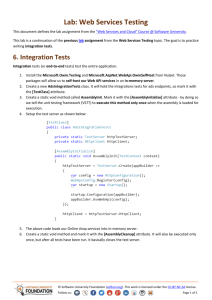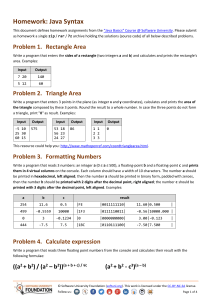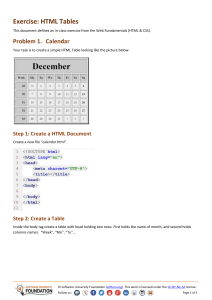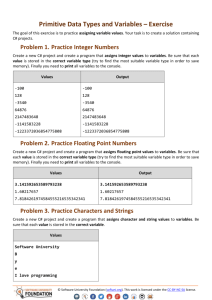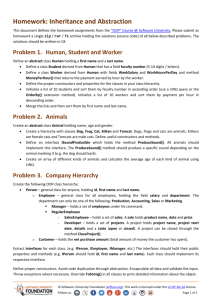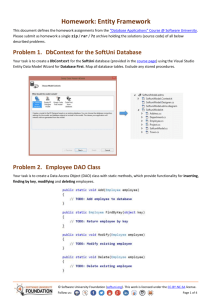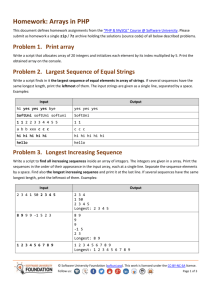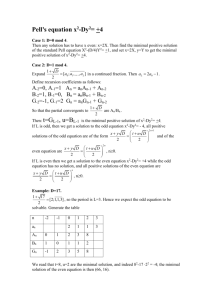Data Structures Homework: Lists & Implementations
advertisement
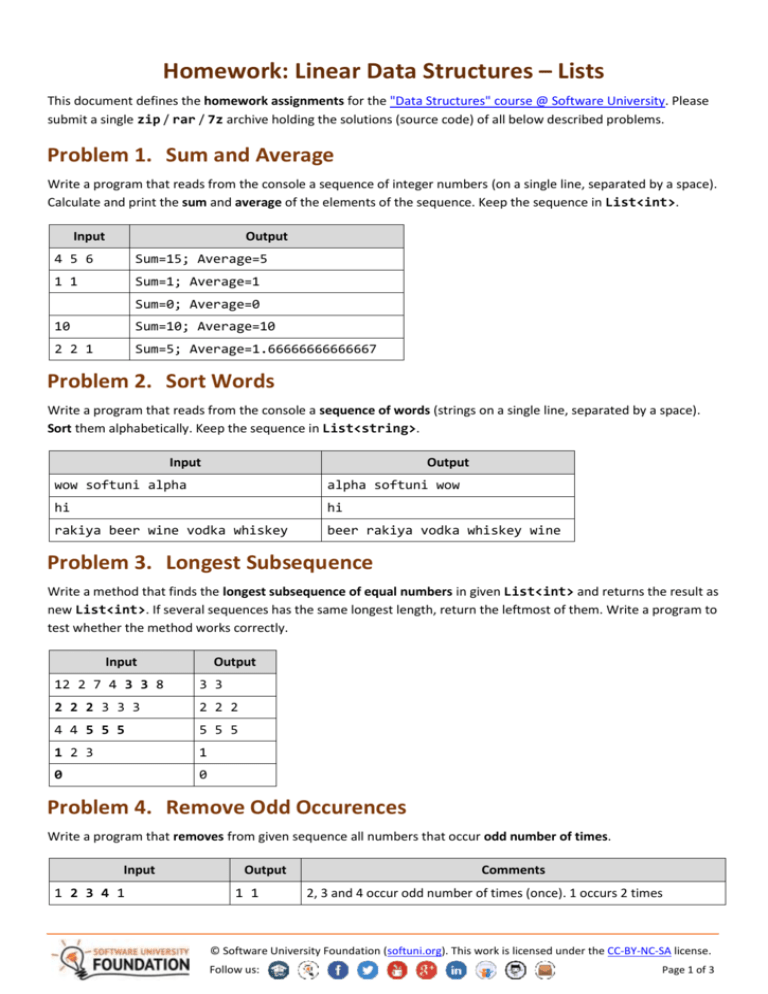
Homework: Linear Data Structures – Lists This document defines the homework assignments for the "Data Structures" course @ Software University. Please submit a single zip / rar / 7z archive holding the solutions (source code) of all below described problems. Problem 1. Sum and Average Write a program that reads from the console a sequence of integer numbers (on a single line, separated by a space). Calculate and print the sum and average of the elements of the sequence. Keep the sequence in List<int>. Input Output 4 5 6 Sum=15; Average=5 1 1 Sum=1; Average=1 Sum=0; Average=0 10 Sum=10; Average=10 2 2 1 Sum=5; Average=1.66666666666667 Problem 2. Sort Words Write a program that reads from the console a sequence of words (strings on a single line, separated by a space). Sort them alphabetically. Keep the sequence in List<string>. Input Output wow softuni alpha alpha softuni wow hi hi rakiya beer wine vodka whiskey beer rakiya vodka whiskey wine Problem 3. Longest Subsequence Write a method that finds the longest subsequence of equal numbers in given List<int> and returns the result as new List<int>. If several sequences has the same longest length, return the leftmost of them. Write a program to test whether the method works correctly. Input Output 12 2 7 4 3 3 8 3 3 2 2 2 3 3 3 2 2 2 4 4 5 5 5 5 5 5 1 2 3 1 0 0 Problem 4. Remove Odd Occurences Write a program that removes from given sequence all numbers that occur odd number of times. Input 1 2 3 4 1 Output 1 1 Comments 2, 3 and 4 occur odd number of times (once). 1 occurs 2 times © Software University Foundation (softuni.org). This work is licensed under the CC-BY-NC-SA license. Follow us: Page 1 of 3 1 2 3 4 5 3 6 7 6 7 6 3 3 7 7 1, 2, 4, 5 and 6 occurs odd number of times removed All numbers occur odd number of times removed 1 2 1 2 1 2 3 7 3 3 4 3 4 3 7 7 4 4 7 3 occurs odd number of times (5) removed 1 1 1 1 All numbers occur even number of times sequence stays unchanged Problem 5. Count of Occurences Write a program that finds in given array of integers how many times each of them occurs. The input sequence holds numbers in range [0…1000]. The output should hold all numbers that occur at least once along with their number of occurrences. Input Output 3 4 4 2 3 3 4 3 2 2 -> 2 times 3 -> 4 times 4 -> 3 times 1000 1000 -> 1 times 0 0 0 0 -> 3 times 7 6 5 5 6 5 -> 2 times 6 -> 2 times 7 -> 1 times Problem 6. Implement the Data Structure ReversedList<T> Implement a data structure ReversedList<T> that holds a sequence of elements of generic type T. It should hold a sequence of items in reversed order. The structure should have some capacity that grows twice when it is filled. The reversed list should support the following operations: Add(T item) adds an element to the sequence (grow twice the underlying array to extend its capacity in case the capacity is full) Count returns the number of elements in the structure Capacity returns the capacity of the underlying array holding the elements of the structure this[index] the indexer should access the elements by index (in range 0 … Count-1) in the reverse order of adding Remove(index) removes an element by index (in range 0 … Count-1) in the reverse order of adding IEnumerable<T> implement an enumerator to allow iterating over the elements in a foreach loop in a reversed order of their addition Hint: you can keep the elements in the order of their adding, by access them in reversed order (from end to start). Problem 7. Implement a LinkedList<T> Implement the data structure singly linked list LinkedList<T> that holds a sequence of linked elements. Define two classes: ListNode<T> holding the value and a pointer to the next element. LinkedList<T> holding the first element + operations Add(T item), Remove(index), Count, IEnumerable<T>, FirstIndexOf(T item), LastIndexOf(T item). © Software University Foundation (softuni.org). This work is licensed under the CC-BY-NC-SA license. Follow us: Page 2 of 3 The LinkedList<T> is very similar to DoublyLinkedList<T> but holds a pointer to the next element only (not to both next and previous elements). Problem 8. * Distance in Labyrinth We are given a labyrinth of size N x N. Some of its cells are empty (0) and some are full (x). We can move from an empty cell to another empty cell if they share common wall. Given a starting position (*) calculate and fill in the array the minimal distance from this position to any other cell in the array. Use "u" for all unreachable cells. Example: © Software University Foundation (softuni.org). This work is licensed under the CC-BY-NC-SA license. Follow us: Page 3 of 3


